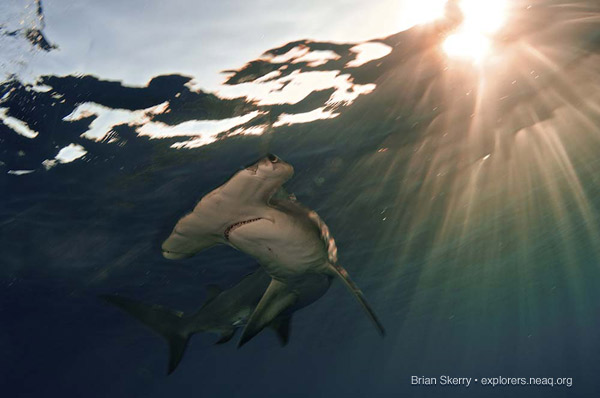This post was written on July 13.
An early morning departure pays off big. In flat calm, we find a group of six
Blainvilles at 6:59 in the morning, and follow them for over 7 hours. The group consisted of two mothers with calves, an adult female, and an adult male. One of the adult females, nicknamed chopper, was missing the top of her dorsal fin. The male was an old battle-scarred fellow, with a remarkable collection of deep gouges and scars all over the top forward half of his body.

Female named "chopper"--it appears that a female beaked whale's life can be pretty rough too.

Old male scars - this is the whale that made a close approach to Roz, and you should see his teeth!
(Photo: BMMRO/K. Ferguson)
We put swimmers on both sides of the boat, but discovered a new twist in the
fecal collection game. A rare bloom of plankton in the region lowered visibility to below 40 feet, making following the whales underwater difficult. In fact, for the swimmers, the whales remained distant shadows and dark shapes for most of the morning, on the edge of our ability to see them. Our hopes of collecting feces improved later in the morning as the whales moved into clearer water, when visibility improved to over 70 feet. Sure enough, Roz got a terrific sample from one of the adult females at 12:38.

Beaked whale group rises to the surface--calves tend to have light colored fins, but all of them have the light circle scars on them--the results of cookie cutter shark attacks. (Photo: BMMRO/K. Ferguson)
The long follow also allowed us to watch the interactions of the whales underwater. Calves stayed close to their moms, tucked either directly underneath her, or directly behind her dorsal fin, appearing to coast along in her wake. The male usually stayed behind or off to the sides of the group, and at one point came up behind Roz in the water, startling her as he swam by within 6 feet! Checking her out--prey? Predator? Threat? Apparently finding her benign (but scaring the daylights out of her in the process), he resumed patrolling the edges of the group.
We stayed with them another hour, then lost track of them on a long dive, as the wind picked up and made sighting conditions difficult. The entire follow lasted over 7 hours, and the whales travelled over 9 miles to the southeast. At 4 p.m. we headed back north, went for one more look offshore from Sandy Point, with no luck. Home by 6 p.m. and off to dinner at a local joint, where the local whist championship was underway. A perfect Bahamian ending to our trip here.
Charlotte Dunn, Kathleen Hunt, and Matthew Grammatico off to seek beaked whales.
(Photo: NEAq/S. Kraus)
We return home tomorrow, but this work will continue for at least another month here. We want to thank
our collaborators at the
Bahamas Marine Mammal Research Organization, especially
Diane Claridge, Charlotte Dunn, and Kendria Ferguson, for their cheerful, dedicated, and hard-working efforts on behalf of this program and all the marine mammals found here. Thanks also to Mike Wiese and the
Office of Naval Research for supporting this and other efforts to unlock the mysteries of the
elusive beaked whales of the Bahamas.
-Scott




















































